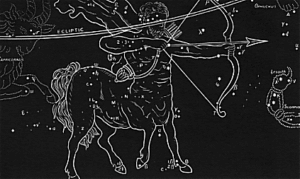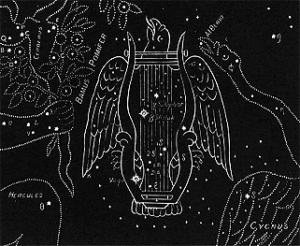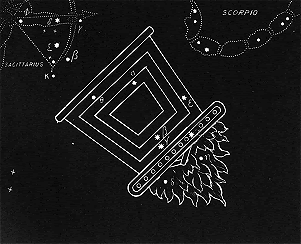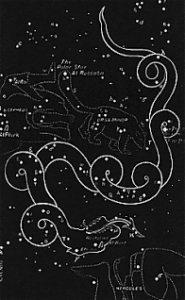Sagittarius: The Archer
Chapter Four: The Redeemer’s Triumph

This is the concluding chapter of the first book of The Witness of the Stars and it pictures the first coming of Jesus Christ. This is the fulfillment of the promised victory of the Seed of the woman in Virgo. Gird your sword upon your side, O mighty one; clothe yourself with splendor and majesty. In your majesty ride forth victoriously in behalf of truth, humility and righteousness; let your right hand display awesome deeds. Let your sharp arrows pierce the hearts of the king’s enemies (this sign has a bowman with the torso and head of a man and the lower body of a horse, pointing His arrow directly at the heart of the Scorpion); let the nations fall beneath your feet (Psalm 45:3-5). In timeless similarity, the apostle John saw the same thing: I looked, and there before me was a white horse! Its rider held a bow, and He was given a crown, and He rode out as a conqueror bent on conquest (Revelation 6:2). This is exactly what is pictured in the sign, now called by the modern Latin name Sagittarius, which means the Archer. The Hebrew and Syriac name of the sign is Kesith, which means the Archer, (Genesis 21:20). The Arabic name is Al Kaus, the arrow, and in Greek it is Toxotes, the archer.
The names of the brightest stars in this sign are significant. The first is called Naim, which in Hebrew means the gracious one. This is precisely what is said of the Messiah, the Victor, in the words immediately preceding the quotation above: Your lips have been anointed with grace, since God has blessed you forever (Psalm 45:2). The second in Hebrew is Nehushta, which means the going or sending forth. We see the same in the Arabic names that have been passed down through the years, Al Warida, who comes forth, and Ruchba or Rami, the riding of the bowman. This is He who will come without warning like an arrow from the bow, full of grace and truth (John 1:14), but a conqueror bent on conquest (Revelation 6:2). God will shoot them with arrows; suddenly they will be struck down. He will turn their own tongues against them and bring them to ruin; all who see them will shake their heads in scorn. All mankind will fear; they will proclaim the works of God and ponder what He has done. Let the righteous rejoice in ADONAI and take refuge in Him; let all the upright in heart praise Him (Psalm 64:7-10)! This brings us to the first of three constellations for the sign of Sagittarius, which takes up the theme of praise to the conqueror.

1. Lyra (The Harp): The Harp beautifully follows the victorious Horseman, for the harp symbolizes the praise and honor that only He deserves. Its brightest star alpha is one of the most glorious in the heavens and makes it easily recognizable. It is called Vega, which means He will be exalted. Its root occurs in the opening of the Song of Moses: I will sing to ADONAI, for He is highly exalted (Exodus 15:1b). Its other stars, beta and gamma are also noticeable stars: beta is called Shelyuk, which means an eagle (as does the Arabic, Al Nesr); and gamma, which is called Sulaphat, springing up, or ascending, as praise. There was praise at Christ’s birth from two sources. First were the angels: Suddenly a great company of the heavenly host appeared praising God and saying, “Glory to God in the highest, and on earth peace to men on whom His favor rests (Luke 2:14).” Secondly, there were the Magi from the east. They saw the Child with His mother Mary, and they bowed down and worshiped Him (Matthew 2:1 and 11). However, there was no praise at the cross. There is a reason the world generally celebrates Christmas, although it is less than enthusiastic about Easter. We see the baby in the manger at Christmas, but all we seek out at Easter are eggs and bunnies. The reason is that a baby in the manger does not threaten us. Babies are cute and cuddly, but a man on a cross dying for my sin is a different story. As the saying goes, “You’ve just gone from preaching to meddling!”
But, one day His praise will rise up, ascending like an eagle toward heaven, when every creature in heaven and on earth and under the earth and on the sea, and all that is in them will sing: To Him who sits under the throne and to the Lamb be praised and honor and glory and power, for ever and ever (Revelation 5:13). However, it will not be until the Messianic Kingdom that the world will praise Him in this way. And why will we praise Him? Because His judgments are true and just (see the commentary on Revelation, to see link click Eu – Hallelujah! The Smoke From Her Goes Up Forever and Ever). This brings us to the altar.

2. Ara (The Altar): Here we have an altar, significantly and ominously placed upside down, with its fires burning and pointing to the abyss (Revelation 9:1-2 and 11). It is south of the Scorpion’s tail, and when first formed, it was visible only on the very lowest horizon of the south, pointing to the completion of all judgment in the lake of fire (Rev 20:14-15). In the Egyptian zodiac we have a different picture, giving us another aspect of the same judgment. It is a man on a throne with a winnowing fork in his hand. His name is Bau, the same name as Hercules, and means He comes. It is from the Hebrew Boh, to come, as in: Who is this coming from Edom, from Bozrah, with His garments stained crimson (Isaiah 63:1)? Why is He coming? He is coming in judgment. For the day of vengeance was in My heart. And the year of My redemption has come. I trampled the nations in My anger; in My wrath I made them drunk and poured their blood on the ground (Isaiah 63:4 and 6). The completion of judgment, therefore, is what is pictured both by the burning altar and the Coming One on the throne, with His threshing instrument.

In Arabic it is called Al Mugamra, which means the completing, or finishing. The Greeks used the word Ara sometimes in the sense of praying, but more frequently in the sense of cursing. This is the curse prophesied against Satan. He (the Seed of the woman) will crush your head (inflicting a fatal blow) in Genesis 3:15. The burning fire points to the completion of that curse, when he will be thrown into the lake of fire, where he will be tormented day and night for ever and ever (Revelation 20:10). This brings us to the close of the first book and that old Serpent, the devil, being thrown out of heaven.
3. Draco (The Dragon): Each of the three books ends with the same apocalyptic truth of God’splan for the world. The same great enemy is referred to in all these pictures. He is the great dragon who was hurled down, that ancient serpent called the devil or Satan, who leads the whole world astray. He was hurled down to the earth and his angels with him (Revelation 12:9). The first book, about His first coming, concludes with the dragon being thrown out of heaven. At the conclusion of the second book we see the Messiah returning with His Church, and Cetus, the sea monster or Leviathan is bound for a thousand years. And the third book, about the Messianic Kingdom, concludes with Hydra, the old serpent, destroyed. Therefore, here, at the end of the first book, we see that the dragon will ultimately be defeated.



Leave A Comment